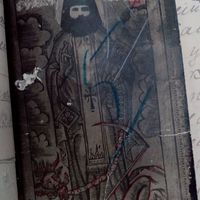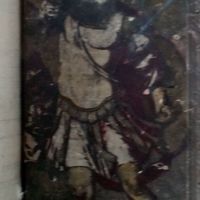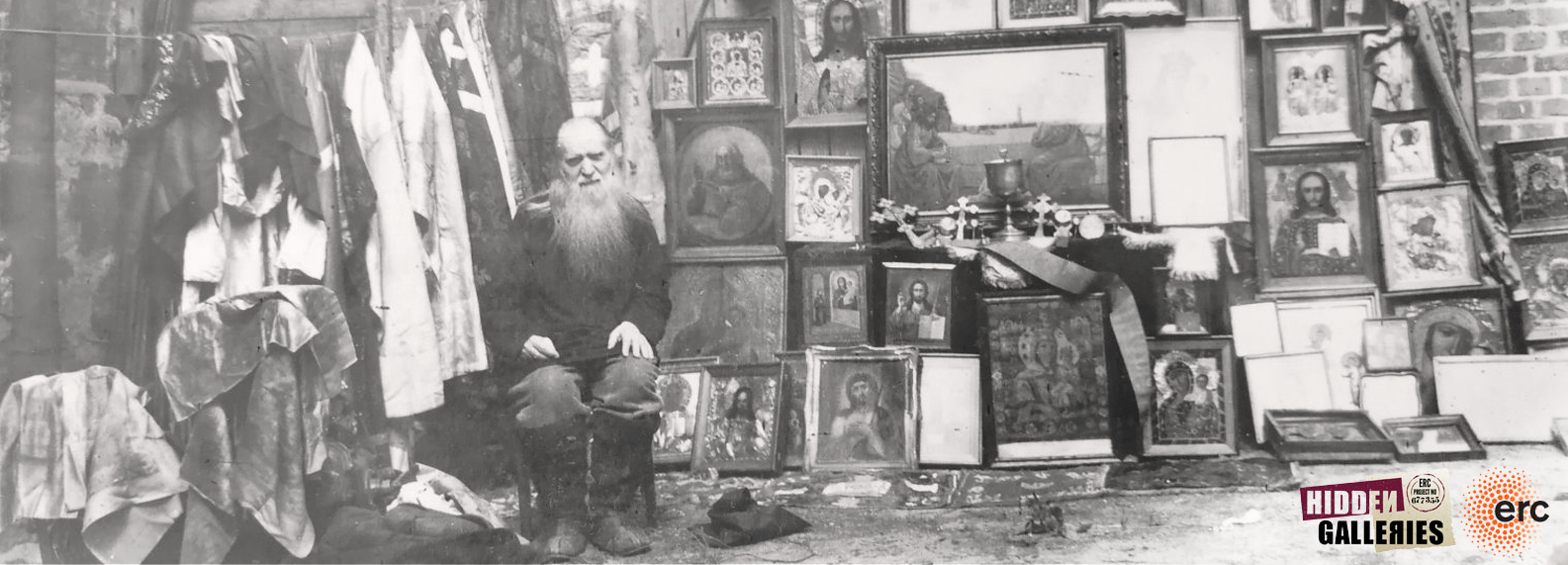Photo-icons of Inochentie of Balta Ukraine
Item
Title
Photo-icons of Inochentie of Balta Ukraine
Imagini iconografice ale lui Inochentie de la Balta, Ucraina
Иконографические образы Иннокентия Балтского, Украина
Description
The four photo-icons of Inochentie of Balta were confiscated by the Soviet secret police in 1921 from the Inochentist community of the village of Lipetcoe (Balta county, Odessa Governorate). The village of Lipetcoe was the spiritual centre of Inochentism, where believers established an underground monastery and a utopian communal society called Gradina Raiului (the Garden of Paradice). In September 1920, a few months after the Red Army occupied Lipetcoe, Soviet authorities closed the monastery and expelled a number of Inochentist leaders from Gradina Raiului. The second major repressive operation took place in 1921, when 55 leading Inochentists were arrested and accused of undermining the authority of local functionaries, spreading anti-Soviet propaganda, and sheltering the regime’s enemies.
Inochentism emerged at the beginning of the 20th century, when photographic technologies became increasingly accessible. Photography quickly acquired an important place in Inochentist sacred art. The Inochentists utilised different photographic techniques for creating images of their saints according to the traditions of Eastern Orthodox iconography. These images were reproduced as photo-icons or postcards and distributed widely.
The first of the four items is a photograph of Inochentie produced by believers before his death in 1917. On this photo icon, Inochentie is represented in monastic habit and in a stance similar to that of the saints in traditional Eastern Orthodox iconography. He holds in his hands the cross and a prayer rope. This photograph is displayed near Orthodox icons in the homes of contemporary followers of Inochentie of Balta.
The second photo icon is a modified version of the previous photograph and was produced through the technique of photo collage. It contains the image of Inochentie holding the cross and the sovereign orb. In Eastern Orthodox Iconography, the sovereign orb appears on icons of Jesus Christ and symbolises imperial power. Inochentie is flanked by the images of two saints seated on clouds, one of whom is the Virgin Mary. The inscription above Inochentie’s head reads: “the Holy Spirit”.
The third icon was produced by replacing the face of an unknown saint with that of Inochentie of Balta, cut out from the first photo icon. Inochentie was renowned for his performance of mass exorcisms at the Monastery of Balta, where his movement started. The image of a defeated and chained Devil is a symbolic reference to Inochentie's power to expel demons.
The fourth photo icon was created through the same techniques as the third one. The face of Inochentie has been cut out from a photograph and applied to an icon of the Archangel Michael. This photo icon of Inochentie of Balta was inspired by the apocalyptic narratives of Inochentists, according to which the mission of Inochentie was to prepare believers for the End of Days.
All four items were multiplied and distributed among the Inochentists, who venerated them as sacred images. The technologies used for producing these icons were not accessible to everyone in Russia at the beginning of the 20th century. Most probably the Inochentists used the services of a professional photography studio. The first photo icon was used in the production of the other three through different techniques.
The presented items are contained in a secret police investigation case file created in 1921, which is preserved in the Archive of SBU Office in Odeska Oblast. The file number 27146 contains 11 photographs and photo icons, one booklet, a number of flyers produced by the Inochentists, and a propaganda flyer of the White Movement with the image of Alexander Kolchak.
For related entries see:
Inochentism emerged at the beginning of the 20th century, when photographic technologies became increasingly accessible. Photography quickly acquired an important place in Inochentist sacred art. The Inochentists utilised different photographic techniques for creating images of their saints according to the traditions of Eastern Orthodox iconography. These images were reproduced as photo-icons or postcards and distributed widely.
The first of the four items is a photograph of Inochentie produced by believers before his death in 1917. On this photo icon, Inochentie is represented in monastic habit and in a stance similar to that of the saints in traditional Eastern Orthodox iconography. He holds in his hands the cross and a prayer rope. This photograph is displayed near Orthodox icons in the homes of contemporary followers of Inochentie of Balta.
The second photo icon is a modified version of the previous photograph and was produced through the technique of photo collage. It contains the image of Inochentie holding the cross and the sovereign orb. In Eastern Orthodox Iconography, the sovereign orb appears on icons of Jesus Christ and symbolises imperial power. Inochentie is flanked by the images of two saints seated on clouds, one of whom is the Virgin Mary. The inscription above Inochentie’s head reads: “the Holy Spirit”.
The third icon was produced by replacing the face of an unknown saint with that of Inochentie of Balta, cut out from the first photo icon. Inochentie was renowned for his performance of mass exorcisms at the Monastery of Balta, where his movement started. The image of a defeated and chained Devil is a symbolic reference to Inochentie's power to expel demons.
The fourth photo icon was created through the same techniques as the third one. The face of Inochentie has been cut out from a photograph and applied to an icon of the Archangel Michael. This photo icon of Inochentie of Balta was inspired by the apocalyptic narratives of Inochentists, according to which the mission of Inochentie was to prepare believers for the End of Days.
All four items were multiplied and distributed among the Inochentists, who venerated them as sacred images. The technologies used for producing these icons were not accessible to everyone in Russia at the beginning of the 20th century. Most probably the Inochentists used the services of a professional photography studio. The first photo icon was used in the production of the other three through different techniques.
The presented items are contained in a secret police investigation case file created in 1921, which is preserved in the Archive of SBU Office in Odeska Oblast. The file number 27146 contains 11 photographs and photo icons, one booklet, a number of flyers produced by the Inochentists, and a propaganda flyer of the White Movement with the image of Alexander Kolchak.
For related entries see:
Aceste reprezentări fotografice ale Ieromonahului Inochentie de la Balta au fost confiscate de poliția secretă sovietică în 1921 de la comunitatea Inochentistă din localitatea Lipețcoe (județul Balta, gubernia Odesa). Satul Lipețcoe a fost centrul spiritual al mișcării inochentiste, unde credincioșii au construit o mănăstire subterană și au întemeiat o comună utopică numită Grădina Raiului. În septembrie 1920, câteva luni după ocuparea județului Balta de Armata Roșie, autoritățile bolșevice au închis mănăstirea și au expulzat din Grădina Raiului liderii Inochentiști. Următoarea operațiune represivă majoră a avut loc în toamna anului 1921, când autoritățile sovietice au arestat 55 de lideri inochentiști acuzați de subminarea autorităților locale, răspândire de zvonuri antisovietice și de adăpostirea dușmanilor regimului.
Mișcarea inochentistă a apărut la începutul secolului al XX-lea, când tehnologiile fotografice deveneau tot mai răspândite și accesibile. Inochentiștii utilizau diferite tehnici fotografice pentru a crea imagini ale sfinților lor ce corespundeau canoanelor iconografiei creștin-ortodoxe și care erau reproduse sub formă de fotografii sau cărți poștale.
Primul dintre obiectele sacre confiscate în 1921 este o fotografie a lui Inochentie de la Balta produse înaintea morții sale, multiplicate și răspândite între inchentiști. Fotografia conține imaginea Ieromonahului Inochentie în ținută monastică și într-o postură similară celei a sfinților în icoanele creștine ortodoxe și ținând în mâna sa dreaptă și în cea stângă crucea și metaniile. Asemenea fotografii pot fi adesea văzute în casele inochentiștilor, alături de icoane.
A doua imagine este o versiune modificată a primei fotografii și a fost produsă prin tehnologia colajului foto. Fotografia conține imaginea Ieromonahului Inochentie ținând crucea și globul crucifer. În iconografia ortodoxă globul crucifer apare în icoanele cu chipul Mântuitorului și reprezintă un însemn al puterii împărătești. Ieromonahul Inochentie este flancat de chipurile a doi sfinți așezați pe doi nori, unul dintre sfinți fiind Fecioara Maria, iar deasupra icoanei este inscripția ”Duhul Sfânt”.
Cea de a doua icoană a fost produsă prin decuparea imaginii feței Ieromonahului Inochentie dintr-un exemplar al primei fotografii și aplicarea acesteia pe litografia unui sfânt ortodox. Inochentie de la Balta este cunoscut pentru practicarea exorcismului public, iar reprezentarea sa biruind un demon înlănțuit, face referire la aceste practici centrale ale inochentismul timpuriu.
A treia icoană a fost produsă prin aceeași tehnologie ca și cea precedentă, prin aplicarea imaginii feței lui Inochentie pe o icoană a Arhanghelului Mihail. Această icoană a fost inspirată de tradiția inochentistă potrivit căreia misiunea Ieromonahului Inochentie era aceea de a pregăti lumea pentru Ceasul de Apoi.
Toate cele patru imagini au fost multiplicate și distribuite între inochentiști, care le venerau drept icoane. În Rusia de început de secol XX, tehnologiile fotografice nu erau accesibile tuturor și, cel mai probabil, pentru producerea obiectelor sacre prezentate au fost folosite serviciile unui atelier fotografic. Prima fotografie a fost folosită pentru producerea celorlalte trei reprezentări iconografice utilizând diferite tehnici.
Fotografiile prezentate se conțin într-un dosar de urmărire penală al poliției secrete sovietice creat în 1921 și păstrat în Arhiva Departamentului Regional al Serviciului de Securitate al Ucrainei din Odesa. Dosarul 27146 conține 11 fotografii și icoane, o broșură, un număr de foi volante produse de inochentiști și una a Mișcării Albe cu imaginea generalului Alexandr Kolceak.
Pentru descrieri similare vezi:
Subject
Totalitarianism
Material culture--Religious aspects
Religious sects
Confiscations
Evidence photographs
Christian saints in art
Icons, Byzantine
Evidence, criminal
Creator
Dumitru Lisnic
Source
Archive of SBU Office in Odeska Oblast, file no. 27146
Publisher
This project has received funding from the European Research Council (ERC) under the European Union’s Horizon 2020 research and innovation programme No . 677355
Date
1921
Contributor
Dumitru Lisnic
Rights
Archive of SBU Office in Odeska Oblast
Format
Image/jpeg
Photo
Photo
Language
RU
Type
Image
Identifier
Archive of SBU Office in Odeska Oblast, file no. 27146
Coverage
20th Century Ukraine and Moldova
Bibliographic Citation
Dumitru Lisnic, "Photo-icons of Inochentie of Balta, Ukraine",
Date Created
2018
 The photograph of Inochentie of Balta
The photograph of Inochentie of Balta  Inochentie of Balta holding the sovereign orb
Inochentie of Balta holding the sovereign orb  Inochentie of Balta defeating the Devil
Inochentie of Balta defeating the Devil  Inochentie of Balta- the angel of Apocalypse
Inochentie of Balta- the angel of Apocalypse 